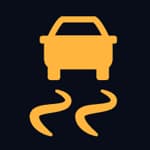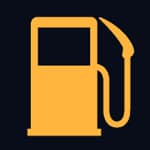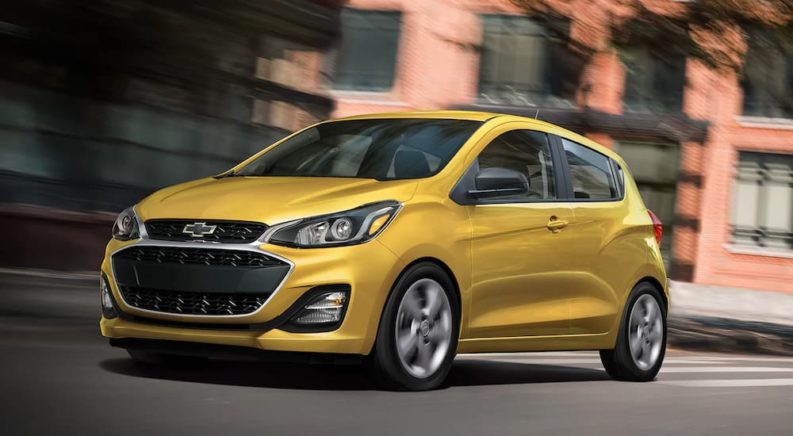So you’ve just gotten your 2022 Chevy Spark! Congratulations, and we bet you’re wondering––what are all those check engine lights and symbols on the dashboard, anyway? What should you know before you go for your first drive?
Vehicle systems grow more complex every year. While this can feel frustrating to the new car owner, remember that these new systems are all designed to bring you a better, safer car. Chevrolet knows that it can take time to learn your new car, so they’ve provided the 2022 Spark with a dashboard designed to quickly tell you what’s happening every time you start the engine.
We’ve Got Your Back
If you’re not the sort of person to sit down and read the manual cover to cover before you get behind the wheel, we understand. Here’s a synopsis of the most important warning lights and indicators on your 2022 Chevy Spark––what they mean and what to do about them.
Where noted, some warning lights should come on briefly when you first start your Spark. This indicates that the light is functioning normally and is ready to provide necessary warnings. If these lights don’t appear when you start your car, have them checked by your dealer.
Once you’ve learned about some of your 2022 Chevy Spark’s most important warning, information, and check engine lights, you can put the manual away and enjoy driving!

Seat Belt Reminders
The light for the driver’s and passenger’s seatbelts both illuminate as blinking and eventually steady lights with a chime until belts are fastened.

Airbag Readiness Light
Flashes on startup. If it turns on or remains on while your car is running, it can mean that your airbag won’t inflate properly when needed. Malfunctioning airbags can also inflate at random, so it’s important to get airbag system problems checked as soon as possible. You also have a Passenger Airbag Status Indicator on the overhead panel. This light will flash “ON” and “OFF” on startup. When passenger airbags are available and ready (when your passenger seat is occupied––a fact the Spark can sense), you’ll see a steady “ON” light. If these lights continue to flash or don’t show at all, have the system checked.

Charging System Light
Appears when the ignition is on but the engine isn’t started. If the light stays on or appears while you’re driving, get it checked as soon as possible, as it indicates a battery or alternator issue. Driving with this light on can drain your battery!

Malfunction Indicator Lamp
This is the well-known Check Engine Light, which looks like the outline of an engine. It’s the warning system for emissions issues, which can cause rough running, escape of pollutants, poor gas mileage, and emissions test failures. Emissions problems involving the catalytic converter can cause engine fires, so a check engine light that doesn’t resolve should always be checked out by your dealer or mechanic. The light should illuminate with ignition, going dark when you turn on the engine.
Checking your engine early after this light’s appearance may help you avoid serious repairs. Some causes for this warning can be easily corrected. For instance, a loose or missing gas cap can cause this light to illuminate, as can poor gas. If you notice the light in conjunction with engine roughness when cold, try running a full tank of different gas through your Spark.
If this light flashes rather than burning steadily, it can indicate a more urgent concern. Try turning your car off for at least ten seconds, then back on again. If the light’s still flashing, drive slowly, avoid hard acceleration and steep hills, and get it checked by your dealer or a mechanic as soon as possible.

Brake System Warning Light
Flashes on startup. If it stays on when you start your engine, it may simply mean that your parking brake is still engaged. If it remains on after you disengage the parking brake, do not drive further until you have your brakes checked.
If this light appears while you’re driving, gradually reduce speed and pull over as soon as possible. A problem here can mean your brakes won’t operate normally, and it may increase your stopping distance. Don’t drive further until your brakes are checked.

Antilock Brake System (ABS) Warning Light
Flashes on startup. If it remains on or comes on while you’re driving, try resetting the system by stopping and restarting your car. A continuing light indicates a problem. If only this light comes on, it likely means that your ABS system isn’t functioning, but your regular brakes are. Reduce your speed until you get it checked. If this light and that for your brake system are both on, you may not have regular brakes either, so stop as soon as you safely can and don’t drive until the brakes have been checked.

Power Steering Warning Light
Flashes on startup. Further illumination indicates a problem with your power steering. Visit your dealer or mechanic for diagnosis.

Traction Control System (TCS)/StabiliTrak Lights
These two systems help you keep your car under control in slippery driving conditions, applying your brakes variably to help avoid skidding. Both systems come on automatically at startup, flashing briefly. The StabiliTrak light (a car with swerving tracks) and TCS light (initials TC) will flash when your Spark is actively applying one or both systems. The Traction Off light (under the StabiliTrak light) will illuminate when you turn that system off. If either system isn’t working correctly, the StabiliTrak light will stay on steadily. You can drive without these aids, but you’ll have less control in slippery conditions, so proceed with caution and have them checked by your dealer.

Engine Coolant Temperature Warning Light
Flashes on startup. Illuminates during driving when your engine is overheating. Since this can damage your engine, pull over as soon as you safely can, turn off your car, and allow it to cool down. If your coolant levels are normal, get the system checked as soon as possible.

Engine Oil Pressure Light
Flashes on startup. A steady light indicates that oil isn’t flowing normally through the engine, and this can generate serious damage. Add oil if you’re low, and see a mechanic promptly if the light doesn’t go out or if the problem recurs. Following the manufacturer’s guidelines for oil changes will go a long way toward helping you maintain your Spark!

Service Vehicle Soon Light
Your Spark may be equipped with this light, which is there to tell you that something needs a check-up. Make sure you get your car into your dealer or mechanic as soon as you can.

Tire Pressure Light
Flashes on startup. A steady light means at least one tire is significantly underinflated, so check the pressure. If this light flashes for around a minute and then stays on, it can mean a problem with the Tire Pressure Monitor System, for which you should see your dealer.

Low Fuel Warning Light
This light, an outlined gas pump, appears when you’re getting low on gas.

Immobilizer Light
Flashes on startup. A steady light indicates a problem with the security system. If turning your car off and on again or using a different key doesn’t affect it, see your dealer.

Reduced Engine Power Light
Flashes on startup. This light––a down arrow inside the Malfunction Indicator Lamp, which will also illuminate––appears when your engine isn’t producing normal power. You can drive, but you’ll have less acceleration and speed capability. If the light stays on, have it checked out.
Driver Information Center (DIC)
This useful panel provides you with all sorts of information. It often will display more detailed messages if you’re having an issue with one of your vehicle’s systems, and you can program it to manage various systems in your car, such as door locks, infotainment, and valet mode. It will also display useful information about your gas mileage, power level, and more. It’s worth taking the time to familiarize yourself with some of its programmable features.

